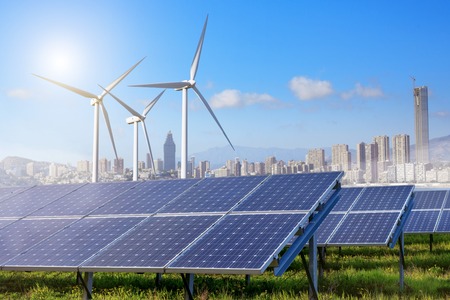In an era of environmental consciousness and sustainable living, the synergy between renewable energy and water conservation has become increasingly vital. As we grapple with climate change, resource depletion, and a growing global population, it’s imperative to explore the interconnectedness of these two critical aspects of our lives. In this blog post, we delve into the profound relationship between renewable energy and water conservation, uncovering the ways in which they complement each other and contribute to a greener, more sustainable future.
The Water-Energy Nexus: A Complex Interplay
To comprehend the intricate relationship between renewable energy and water conservation, we must first grasp the concept of the water-energy nexus. This nexus refers to the inextricable link between water resources and energy production and consumption. Energy production, whether from fossil fuels or renewable sources, relies heavily on water, while water treatment and distribution require copious amounts of energy. This symbiotic connection underscores the need for a holistic approach to resource management.
Water for Energy: The Untold Story
When you think of energy production, you probably envision wind turbines, solar panels, or hydropower dams. While these renewable sources are undoubtedly more sustainable than fossil fuels, they are not without their water-related challenges.
Hydropower: Hydropower, a renewable energy source that harnesses the energy of flowing water, is perhaps the most obvious example of the water-energy nexus. Dams and reservoirs are built to capture water, which is then released to generate electricity. However, these structures can disrupt local ecosystems and limit water availability downstream, impacting aquatic life and agricultural practices.
Solar Power: Solar panels require water for manufacturing and cleaning. Moreover, solar installations in arid regions may increase water demand for cooling systems. While these water requirements are relatively low compared to fossil fuel-based power plants, they still warrant consideration.
Wind Power: The production of wind turbines involves significant water usage, particularly in the manufacturing and mining of materials like steel and rare earth elements. Sustainable practices in these industries can mitigate the water footprint of wind energy.
Biomass Energy: Biomass energy, derived from organic materials, often requires substantial water for irrigation and processing. Sustainable biomass practices aim to minimize water consumption and environmental impacts.
In each case, it’s clear that renewable energy is not entirely free from water-related concerns. Therefore, the path to sustainable energy production involves not only reducing greenhouse gas emissions but also addressing water usage and its environmental consequences.
Energy for Water: The Hidden Connection
Conversely, water conservation efforts are intrinsically linked to energy consumption. The treatment, distribution, and heating of water demand a significant amount of energy. By improving water efficiency, we can simultaneously reduce energy consumption and greenhouse gas emissions. Here are some key ways in which energy and water conservation intersect:
Low-Flow Fixtures: Installing low-flow faucets, showerheads, and toilets reduces water usage. This not only conserves water but also lowers the energy required to heat and distribute hot water.
Wastewater Treatment: The treatment of wastewater is an energy-intensive process. Advanced treatment technologies and energy-efficient systems can mitigate the energy footprint of water treatment facilities.
Agriculture: Agriculture is a major consumer of both water and energy. Implementing precision irrigation systems and adopting sustainable farming practices can reduce water and energy use in agriculture.
Industrial Processes: Industries that rely on water, such as manufacturing and mining, can significantly reduce their energy consumption by optimizing water usage and recycling processes.
A Win-Win Scenario: Renewable Energy and Water Conservation Solutions
While the water-energy nexus presents challenges, it also offers opportunities for synergy between renewable energy and water conservation. By adopting integrated strategies, we can create a more sustainable and resilient future.
- Renewable Energy-Powered Desalination
Desalination, the process of converting seawater into freshwater, is a crucial solution to address water scarcity in many regions. Traditionally, desalination has been energy-intensive and environmentally impactful. However, pairing renewable energy sources like solar and wind with desalination plants can make the process more sustainable. Solar desalination, in particular, is gaining traction as a clean and efficient way to produce freshwater. - Green Buildings and Smart Grids
The construction industry is increasingly focusing on green building practices that incorporate both renewable energy and water-efficient systems. Smart grids, which optimize energy distribution and consumption, can work in tandem with water management systems to minimize resource waste in urban environments. - Eco-Friendly Farming
Agriculture consumes a substantial portion of the world’s freshwater resources. By adopting renewable energy solutions for irrigation, implementing precision agriculture techniques, and optimizing energy use in food processing, the agricultural sector can contribute to both energy and water conservation. - Research and Innovation
Investing in research and innovation is paramount. Collaborative efforts between scientists, engineers, and policymakers can yield breakthroughs in water-efficient energy production technologies and sustainable water management practices.
Conclusion: A Holistic Approach to Sustainability
Renewable energy and water conservation are two sides of the same coin in our quest for a sustainable future. Recognizing their interconnectedness is crucial in addressing the challenges posed by climate change, resource scarcity, and environmental degradation. By embracing integrated solutions, we can mitigate the environmental impact of both energy production and water management, ensuring a more resilient and eco-friendly world for generations to come. It’s a journey that requires dedication, collaboration, and a shared commitment to safeguarding our planet’s precious resources.



